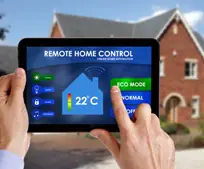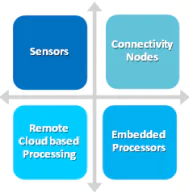
At the recently concluded Consumer Electronics Show (CES) 2014, one of the most exciting technology innovations doing the rounds was ‘Connected Cars’. With major car manufacturers showing off their expertise in connecting your smartphone to them, some of the adventurous built a native operating system for their make of vehicles. The search engine giant Google announced the Open Automotive Alliance- Android operating system for cars.
Automobiles are rapidly transforming into context aware machines that know where they are, where others vehicles are (both local and providing a macro view of traffic). They can also warn of impending mechanical or other problems, thanks to numerous built-in sensors. These interconnected objects regularly collect data, analyze and use it to trigger action, providing a myriad of intelligence resulting in improved planning, better management and effective, rapid decision making. This is the world of Internet of Everything.
Internet of Everything, commonly referred to as ‘IoE’ has many definitions, as the wide nature of its applications. The IoE can be defined as connection of things, also known as Internet of Things (IoT), people, processes, Machine –to-Machine (M2M) interactions and data over the public/private IP network. The subset of IoE, i.e. Internet of Things (IoT) has seen its applications being utilized in diverse and wide fields. Among the most prospective vertical application domains are consumer electronics, automotive, and healthcare, as well as intelligent buildings and utilities.
According to research firm Gartner the Internet of Everything, which excludes PCs, tablets and smartphones, will grow to 26 billion units in 2020 from 0.9 billion in 2009, a growth-fold of more than 30. IoE product and service suppliers will generate incremental revenue exceeding $300 billion, mostly in services. It will result in $1.9 trillion in global economic value-add through sales into diverse end markets.
Before we take a look at some of the recent examples in IoE, let us flip through the main attributes that make “things” a part of the Internet of everything or IoE.
Building Blocks of the IoE:
- Sensing Nodes: Sensing Nodes are what you can call your eye, ear, nose etc. on the ground. They could include a camera system for image monitoring, laser emitters to detect amount of pollution, flow meters to monitor energy consumption. These uniquely identifiable nodes would be controlled via a remote command and control topology.
- Locally Embedded Processing Nodes: Microprocessors(MPU) and Micro controllers (MCU)provide the much needed real- time local embedded processing capability, a key requirement for most IoE applications.
- Communication- Wired and Wireless: Communication nodes act as the bridge to transfer information gathered by the sensing nodes and processed by embedded processors.
- Software to Automate Tasks: Software plays a compelling role – enabling the underlying M2M interactions while the hardware provides the foundation of connectivity.
- Remote Embedded Processing (Access to cloud computing): Some IoE providers/enablers provide sensors, controllers to consumers as a cloud resource (under infrastructure as a service (IaaS) offering). Albeit some of them would prefer to use the cloud only for minimalistic access and believe in processing to be done locally.

Various smart machines in this IoE environment collaborate and communicate with other machines, people, objects infrastructures and the environment around them, resulting in generation of huge volumes of data and process that data into meaningful actions to command and control things to make life easier for people. Let us take a look at some of the current examples/applications of IoE.
Smart Homes: The most widely recognized example of Internet of Everything is the ‘Smart Home’. Smart Homes include but not limited to centralized control of lighting, security, heating, ventilation and entertainment media devices, connected via a local server or gateway, to provide augmented comfort, energy efficiency and security especially for the elderly.
Healthcare and Wellness: The most prominent of Machine-to-Machine (M2M) and Machine-to-People (M2P) applications can be seen in the field of healthcare. It can be segmented into e-health, m-health, tele-medicine and assisted living. With the advent of wearable devices to monitor bodily functions, patients with non-life threatening conditions can be sent home with a wearable sensor system that can remotely read a patient’s biometrics, sending the data to the physician and allowing users to go about their daily lives outside of a clinical setting. This will free up precious and scarce hospital resources, which can then be utilized for urgent cases.
Buildings: The range of automation and smart devices installed in our homes can very well be scaled up to large infrastructures like buildings, tunnels, shopping malls etc. All such buildings consume energy through Heating, ventilation and air-conditioning systems (HVAC). Apart from the cost –saving smart energy solutions, we have sensors built inside the infrastructure to constantly monitor it’s structural integrity.
Manufacturing- Maintaining Quality: Using host of different sensors, cameras, lasers etc. to analyze the manufacturing processes in real time, one can determine if the output is good or bad based on its physical characteristics.
Also the machines used to manufacture these parts have sensors built in them to determine their operational availability. With a smart predictive maintenance in place, the manufacturing industry can benefit massively.
Environmental Monitoring: With over 7 Billion people, the ultimate goal of IoE is to build a smart planet. Internet of Everything offers distinctive opportunities to address grave issues like- clean water, air pollution. Also smart bins, use real time data to alert municipal services whether a bin needs to be picked up, or is only X% filled, or it contains any hazardous material which needs to be picked up right away. These alerts would optimize the waste collection routes and save the already scarce public services a ton of money and resources.
To sum it up, Internet of Everything, as the name suggests, is expected to touch and transform every facet of our lives. From industry automation, automobile connectivity to wearable devices and smart home appliances, it will make our way of living more enriching. There is a long road ahead to cover for IoE, but one thing is for sure, it is going to be amazing. The relevant hashtag for the Internet of Everything is #IoE – just in case you want to join the discussion.





